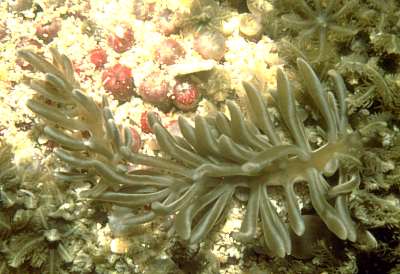
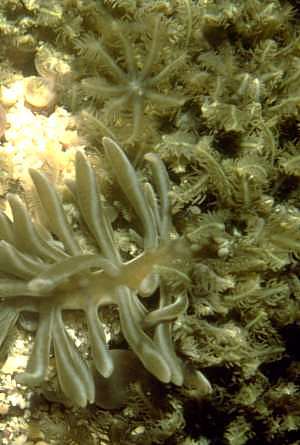
Phyllodesmium colemani
Rudman, 1991
Order: NUDIBRANCHIA
Suborder: AEOLIDINA
Family: Glaucidae
DISTRIBUTION
Western Pacific [Lord Howe Island, Philippines]
PHOTO
Upper Photo: 2 animals, large one on right is Holotype, 18mm long preserved, AM C161935. Smaller animal, 12mm long preserved, is a paratypes, AM C155175. Lower Photo: anterior end of holotype in colony of Tubipora musica, Lord Howe Island. Photo: Neville Coleman.
The body is narrow and elongate with up to eleven groups of cerata down each side of the body. Both the oral tentacles and the rhinophores are long smooth and tapering. The foot is narrow, no wider than the body, and at its anterior end it broadens to form a wide semicircular leading edge with angular corners. The precardiac cerata on each side are arranged in a single-rowed arch of about ten cerata, the uppermost being the longest. The postcardiac cerata are arranged in a series of up to ten vertical rows spaced evenly down the body and usually slightly raised on ridges. The number of cerata in each row progressively decreases posteriorly, the first postcardiac row having up to six cerata and the most posterior sometimes reduced to a single row. As in the precardiac cerata, the uppermost ceras in each row is the longest.
The colour pattern appears to be variable. In animals from the type locality [Lord Howe Island]the body and cerata are a translucent greenish brown with small brown specks clearly visible on the dorsal surface of the body and the cerata. There are greenish white patches down either side of the body below and between the cerata. The edges of the somewhat flattened cerata are lined with a band of greenish white which join at the tip of the ceras. In specimens illustrated in the Forum for the Philippines the background brown lacks a greenish tinge and on the cerata there are scatterd white patches. I assume the difference in brown reflects a differences in the colour of the zooxanthellae which are stored in the modified ducts of the digestive gland [see page on Solar powered slugs.
This species apparently feeds exclusively on the stoloniferan Organ pipe Coral, Tubipora musica.
Reference:
• Rudman, W.B. (1991). Further studies on the taxonomy and biology of the octocoral-feeding genus Phyllodesmium Ehrenberg, 1831 (Nudibranchia: Aeolidoidea). Journal of Molluscan Studies, 57: 167-203.
Rudman, W.B., 2003 (December 21) Phyllodesmium colemani Rudman, 1991. [In] Sea Slug Forum. Australian Museum, Sydney. Available from http://www.seaslugforum.net/find/phylcole
Related messages
Phyllodesmium colemani from Indonesia
July 6, 2007
From: Aaron Fink
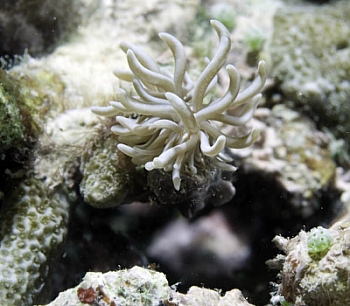
Bill:
Thanks for your help with my recent nudibranch image collection from our Indonesian trip. As per your suggestion, I am posting the image of this unknown Phyllodesmium species that I photographed there in hopes that other members might be able to assist in its identification.
Locality: Gamfi Island, 30 feet, Indonesia, Banda - Raja Ampat, 21 October 2006, Coral reef. Length: 1.5 - 2 cm. Photographer: Aaron Fink.
Best
Aaron
afink01@comcast.net
Fink, A. S., 2007 (Jul 6) Phyllodesmium colemani from Indonesia. [Message in] Sea Slug Forum. Australian Museum, Sydney. Available from http://www.seaslugforum.net/find/19669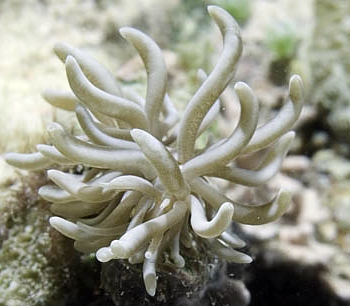
Dear Aaron,
I think this may be Phyllodesmium colemani which feeds exclusively on the stoloniferan 'Organ pipe Coral', Tubipora musica. Your animal is sitting on a cnidarian colony but I can't see if it is Tubipora or not. Another possibility is P. briareum but in that species the brown zooxanthellae are arranged in longitudinal rows down each ceras which doesn't seem to be the case from what I can see in your photo. There is also the possibility that it is another unnamed species. Sorry I can't be more definite but this genus, like so many other nudibranchs is still a 'work in progress'.
Best wishes,
Bill Rudman
Another Phyllodesmium colemani from the Philippines
December 22, 2003
From: Erwin Köhler
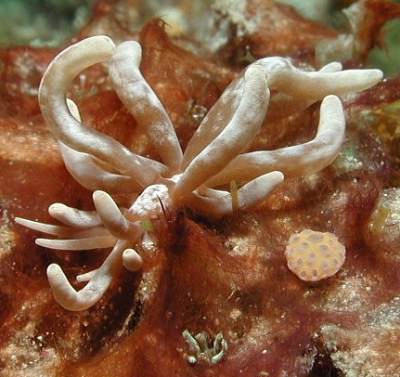
Dear Bill,
Some time ago i sent to you some shots of (what i think to be) Phyllodesmium colemani. Here is one more from the Philippines, Panglao is., Alona Beach, divesite "BBC".
data:
length 19mm
depth 17m
date 17 Oct. 2003
Regards,
Erwin
Erwin@Philippine-Sea-Slugs.com
Köhler, E., 2003 (Dec 22) Another Phyllodesmium colemani from the Philippines. [Message in] Sea Slug Forum. Australian Museum, Sydney. Available from http://www.seaslugforum.net/find/11700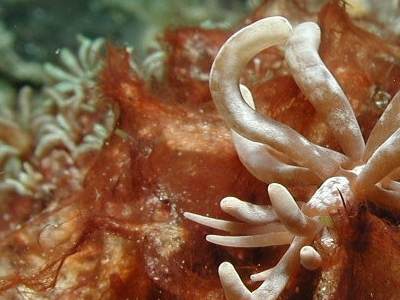
Thanks Erwin,
It certainly seems to be Organ pipe Coral [Tubipora] in the background, whicih is the food of that species
Best wishes
Bill Rudman
Phyllodesmium colemani from Lord Howe Island
December 22, 2003
From: W.B. Rudman
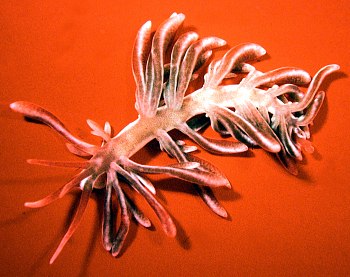
Here is a photo record from Ian Hutton of Phyllodesmium colemani from Lord Howe Island.
Location: Blunts Hole.
Bill Rudman
Rudman, W.B., 2003 (Dec 22) Phyllodesmium colemani from Lord Howe Island. [Message in] Sea Slug Forum. Australian Museum, Sydney. Available from http://www.seaslugforum.net/find/8980Phyllodesmium colemani ? from the Philippines
December 21, 2003
From: Erwin Köhler
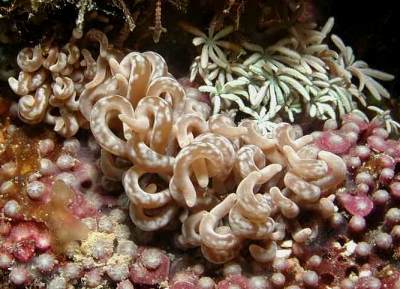
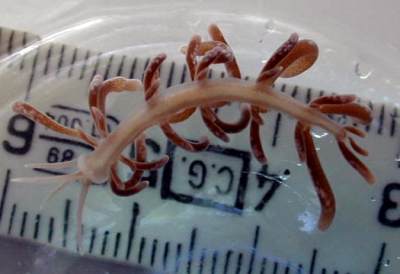
Dear Bill,
Here are 2 shots of 3 Phyllodesmium from the Philippines, Cebu Island, divesite "airplane", which Ingo Burghardt [email ingo.burghardt@ruhr-uni-bochum.de] thinks to be Phyllodesmium colemani. Ingo is doing some research on 'solar powered sea slugs' and thought we should ask the person who described this animal to be sure. I collected two of them (as I thought) but in my room I realised there were three. So I took one shot in a dish - ventral view.
data:
Length 28mm [ventral photo], 31 and 72mm, [upper photo]
depth 7m
date 15 May 2003
Cheers,
Erwin
Erwin@Philippine-Sea-Slugs.com
Köhler, E., 2003 (Dec 21) Phyllodesmium colemani ? from the Philippines. [Message in] Sea Slug Forum. Australian Museum, Sydney. Available from http://www.seaslugforum.net/find/11074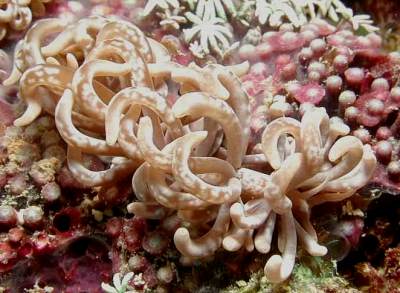
Dear Erwin,
Sorry for the delay in answering this. If it makes you feel any better you are not the only one with messages which are taking a long time to answer. Even though I named this species, there are so few records of it that I can't admit to being an expert on its identity. Specimens from Lord Howe Island seem to have a rather different colour pattern, lacking the white blotches found in animals from the Philippines, but I suspect that reflects a natural variability rather than different species. The general shape, ceratal arrangement and preference ofr Tubipora musica all suggest it is P. colemani
Best wishes
Bill Rudman
